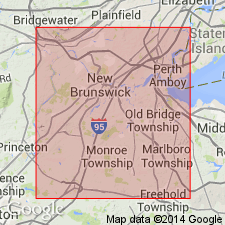
- Usage in publication:
-
- Farrington sand member*
- Modifications:
-
- Named
- Dominant lithology:
-
- Sand
- AAPG geologic province:
-
- Atlantic Coast basin
Summary:
Farrington sand member of Raritan formation, here named, consists of medium- to fine-grained sand (No. 1 sand of previous reports) in lower part of Raritan between Woodbridge clay above and Raritan fire clay below. Separated from Sayreville sand member (new name) by Woodbridge clay. Lower part, 10 to 20 ft thick, is coarse, arkosic, light-gray, or light-yellow sand commonly containing sprinkling of small pebbles. Arkosic material, as seen in outcrop, is partly kaolinized, the white kernels of the partly decomposed feldspar standing out in contrast to the gray and yellow sand and gravel; occasionally the gravelly beds contain numerous small chunks of red and white clay. Lenses of clay, commonly only a few feet thick, are present, and thin clay seams are fairly commmon within limits of member. Thickness 80 ft. Most of the discussion deals with relation of unit to ground-water supply. In this report, Woodbridge and Raritan clays are considered informal economic names.
Source: GNU records (USGS DDS-6; Reston GNULEX).
For more information, please contact Nancy Stamm, Geologic Names Committee Secretary.
Asterisk (*) indicates published by U.S. Geological Survey authors.
"No current usage" (†) implies that a name has been abandoned or has fallen into disuse. Former usage and, if known, replacement name given in parentheses ( ).
Slash (/) indicates name conflicts with nomenclatural guidelines (CSN, 1933; ACSN, 1961, 1970; NACSN, 1983, 2005, 2021). May be explained within brackets ([ ]).

